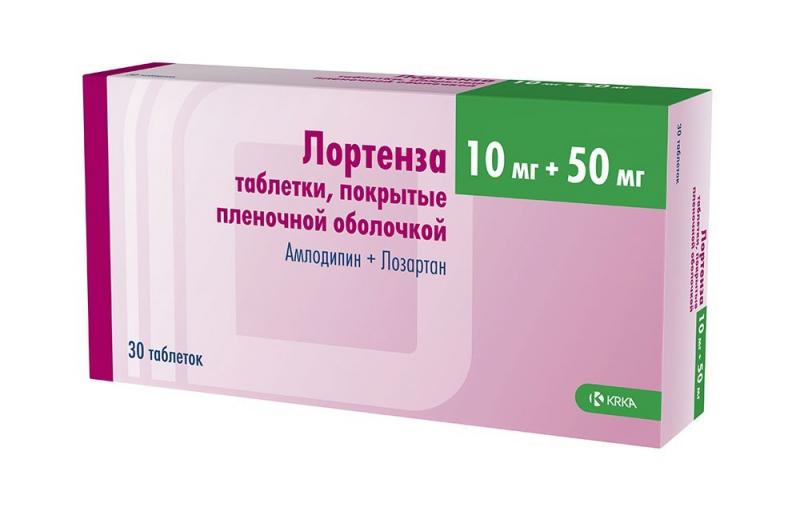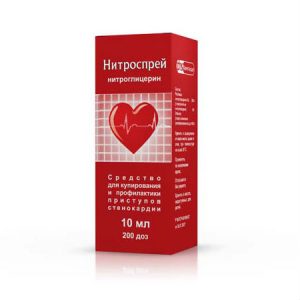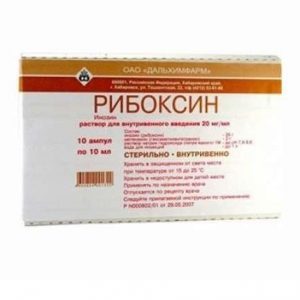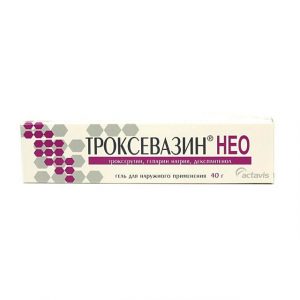Description
Release form
Tablets.
Packing
Per pack 30 pcs.
Pharmacological action
Pharmacological action – antihypertensive.
Contraindications
hypersensitivity to the active components and / or auxiliary components of the drug
pregnancy and lactation period (see ² ÑUse in pregnancy and lactation ² Ñ)
severe liver failure (more than 9 points on the Child-Pyemp scale) srdlk stenosis of the aortic orifice
shock
age 18 years (efficacy and safety not established)
severe arterial hypotension.
Composition
Active substances: losartan, amlodipine.
Dosage and administration
Inside, 1 time / day, regardless of the time of administration, write with a small amount of water.
The recommended dose of Lortenza is 1 tablet / day.
The drug Lortenza at a dose of 5 mg + 50 mg is prescribed to patients who have not achieved adequate control of blood pressure when using amlodipine at a dose of 5 mg or losartan at a dose of 50 mg in monotherapy.
The drug Lortenza at a dose of 5 mg + 100 mg is prescribed to patients who have not achieved adequate control of blood pressure when using losartan at a dose of 100 mg or the drug Lortens at a dose of 5 mg + 50 mg.
The drug Lortenza at a dose of 10 mg + 50 mg is prescribed to patients who have not achieved adequate control of blood pressure when using amlodipine at a dose of 10 mg or Lortens at a dose of 5 mg + 50 mg.
The drug Lortenza at a dose of 10 mg + 100 mg is prescribed to patients who have not achieved adequate control of blood pressure when using the drug Lortenza at a dose of 5 mg + 100 mg or 10 mg + 50 mg.
The dose is selected after previously titrated doses of the individual components of the drug. If a change in the dose of one of the active substances in a fixed combination preparation is required (for example, in connection with a newly diagnosed disease, a change in the patient’s condition or drug interaction), an individual selection of doses of the individual components is necessary. The maximum daily dose is 10 mg + 100 mg.
Patients taking losartan and amlodipine at the same time can be transferred to a Lortenza drug containing losartan and amlodipine in the same doses.
In patients with impaired renal function with CC from 50 to 20 ml / min, dose adjustment is not required. The drug Lortenza is contraindicated in patients with CC less than 20 ml / min and in patients undergoing hemodialysis.
Patients with impaired liver function (less than 9 Child-Pugh scores) should have a lower history of losartan. Due to the lack of a dosage containing 25 mg of losartan in the drug Lortenza, this dose should be prescribed in monotherapy with losartan. The use of the drug Lortenza is possible in patients with impaired liver function (less than 9 points on the Child-Pugh scale), who, by the decision of the doctor, recommended the use of losartan in a dose of 50 mg.
In patients with reduced BCC (for example, due to treatment with high doses of diuretics, etc.), the initial dose of losartan should be reduced to 25 mg 1 time / day. Due to the lack of a dosage containing 25 mg of losartan in the drug Lortenza, this dose should be prescribed in monotherapy with losartan. Before using the drug Lortensa, it is necessary to restore the BCC and the sodium content in the blood plasma.
In elderly patients, dose adjustment of Lortenza is not required, but the dose should be increased carefully.
The drug Lortenza should not be prescribed to children and adolescents under the age of 18 years, because there are no data on the efficacy and safety of use in this group of patients.
Side effects
Side effects (PE), noted during the study of the drug are presented in accordance with the WHO classification according to frequency of occurrence: very often (more than 1/10) often (more than 1/100, less than 1/10) infrequently (more than 1/1000, less than 1/100) rarely ( more than 1/10000, less than 1/1000) and very rarely (less than 1/10000), including individual messages, the frequency is unknown (it is impossible to estimate the frequency from the available data).
From the nervous system: often – dizziness, headache infrequently – drowsiness.
General disorders and disorders at the injection site: infrequently – asthenia, discomfort or pain in the chest, a feeling of fullness in the abdomen, peripheral edema.
From the gastrointestinal tract: infrequently – constipation, discomfort in the abdomen, dyspepsia, vomiting, esophageal reflux.
From the skin and subcutaneous tissues: infrequently – skin itching, urticaria.
From the CCC: infrequently – a feeling of palpitations, flushing of the face, orthostatic hypotension.
From the respiratory system, chest and mediastinal organs: infrequently – shortness of breath.
Hearing organ and labyrinth disorders: infrequently – systemic dizziness.
From the kidneys and urinary tract: infrequently – increased frequency of urination.
PE, observed during the administration of components (amlodipine and losartan), can also serve as its potential PE, despite the fact that these PEs were not observed in clinical trials and in the post-registration period of drug use.
Amlodipine
From the side of the central nervous system: often – headache (especially at the beginning of treatment), dizziness, increased fatigue, drowsiness infrequently – general malaise, hyperesthesia, paresthesia, peripheral neuropathy, tremor, insomnia, unusual dreams, increased irritability, anxiety is very rare – migraine, apathy, agitation, ataxia, amnesia, asthenia, increased sweating.
From the psyche: infrequently – mood lability, depression.
From the digestive system: often – nausea, abdominal pain infrequently – vomiting, constipation or diarrhea, flatulence, dyspepsia, anorexia, dry mucous membranes of the mouth, thirst rarely – gum hyperplasia, increased appetite very rarely – pancreatitis, gastritis, jaundice ( due to cholestasis), hyperbilirubinemia, increased activity of hepatic transaminases, hepatitis.
From the CCC side: often – palpitations are rare – excessive decrease in blood pressure is very rare – fainting, shortness of breath, vasculitis, orthostatic hypotension, development or worsening of the course of chronic heart failure, cardiac arrhythmias (including bradycardia, ventricular tachycardia and atrial fibrillation), myocardial infarction, chest pain, pulmonary edema, edema of the lower extremities.
From the hemopoietic and lymphatic systems: very rarely – thrombocytopenic purpura, leukopenia, thrombocytopenia.
From the urinary system: infrequently – rapid urination, painful urination, nocturia is very rare – dysuria, polyuria.
From the genitals and mammary gland: infrequently – gynecomastia, impotence.
From the respiratory system: infrequently – shortness of breath, rhinitis is very rare – cough.
From the musculoskeletal system: infrequently – muscle cramps, myalgia, arthralgia, back pain, arthrosis rarely – myasthenia gravis.
From the skin: often – flushing of the face skin rarely – exfoliative dermatitis, Stevens-Johnson syndrome is very rare – alopecia, xeroderma, cold sweat, impaired skin pigmentation.
Allergic reactions: very rarely – itching, rash (including erythematous, maculopapular, urticaria), Quincke’s edema, erythema multiforme, photosensitivity reactions.
From the sensory organs: infrequently – tinnitus, diplopia, disturbance of accommodation, xerophthalmia, conjunctivitis, eye pain is very rare – parosmia.
From the side of metabolism: very rarely – hyperglycemia.
Other: infrequently – weight loss, weight gain, nosebleeds.
losartan
From the side of the central nervous system: often – dizziness, asthenia, headache, fatigue, increased weakness, insomnia infrequently – impaired cerebral circulation, sleep disturbances, drowsiness, memory impairment, peripheral neuropathy, paresthesia, hyperesthesia, tremor, ataxia, systemic dizziness, memory impairment, migraine, nervousness.
General disorders and disorders at the injection site: facial swelling, fever, asthenia, increased weakness.
From the gastrointestinal tract: often – nausea, diarrhea, dyspepsia, abdominal pain infrequently – anorexia, taste disturbance, constipation, toothache, dry mouth, flatulence, gastritis, hepatitis, impaired liver function, pancreatitis.
On the part of the skin and subcutaneous tissues: infrequently – alopecia, dry skin, skin rash, redness of the skin, Shenlein-Genoch purpura, photosensitivity, itching, increased sweating.
Allergic reactions: infrequently – urticaria, angioedema.
From the CCC side: infrequently – myocardial infarction, angina pectoris, cardiac arrhythmias (atrial fibrillation, sinus bradycardia, tachycardia, ventricular tachycardia, ventricular fibrillation), palpitations, orthostatic hypotension, syncope (syncope), arterial hypotension, vasculitis.
From the blood and lymphatic system: infrequently – anemia rarely – thrombocytopenia.
From the respiratory system, chest and mediastinal organs: often – shortness of breath, bronchitis, dry cough, discomfort in the pharynx, nosebleeds, rhinitis, laryngitis, chest pain.
On the part of the hearing organ and labyrinth disorders: infrequently – ringing in the ears.
From the side of the kidneys and urinary tract: infrequently – violation of the frequency of urination, nocturia, urinary tract infection is very rare – renal failure.
Mental disorders: infrequently – anxiety, anxiety disorder, confusion, depression, unusual dreams, panic disorder.
From the side of the organ of vision: infrequently – blurred vision, burning sensation / injection in the eye, conjunctivitis, decreased visual acuity.
From the genitals and mammary gland: infrequently – decreased libido, impotence.
On the part of metabolism and nutrition: infrequently – gout.
From the side of musculoskeletal and connective tissue: often – cramps, musculoskeletal pain, swelling of the joints, joint stiffness infrequently – arthralgia, arthritis, fibromyalgia rarely – rhabdomyolysis.
Drug interaction
The antihypertensive effect may be enhanced when used simultaneously with other antihypertensive drugs, so the simultaneous administration of various antihypertensive drugs should be justified.
Amlodipine
May be used safely in the treatment of hypertension with thiazide diuretics, β-blockers, or ACE inhibitors. Unlike other BKK, a clinically significant interaction of amlodipine (III generation of BKK) was not found when combined with NSAIDs, including with indomethacin. It is possible to enhance the hypotensive effect of BCC when combined with thiazide and loop diuretics, ACE inhibitors and nitrates, as well as increase their hypotensive effect when combined with? 1-adrenoblockers, antipsychotics.
The combined use of amlodipine with CYP3A4 inhibitors requires careful monitoring of symptoms of hypotension and peripheral edema. With the simultaneous administration of diltiazem at a dose of 180 mg per day and amlodipine at a dose of 5 mg per day for elderly patients, the systemic exposure of amlodipine is increased by 60%. Erythromycin, when used together, increases the Cmax of amlodipine in young patients by 22%, and in elderly patients by 50%. At the same time, strong CYP3A4 inhibitors (ketoconazole, itraconazole, ritonavir) can increase the concentration of amlodipine in plasma to an even greater extent.
Despite the fact that an accurate quantitative assessment of the interaction of amlodipine and CYP3A4 inducers (e.g. rifampicin, St. John’s wort perforated) has not been obtained, constant monitoring of blood pressure is recommended against the background of their combined use. ? -adrenoblockers with simultaneous administration with amlodipine can cause an exacerbation of the course of heart failure.
Although a negative inotropic effect was not usually observed in the study of amlodipine, nevertheless, some BCCs may increase the severity of the negative inotropic effect of antiarrhythmic drugs that cause a prolongation of the QT interval (e.g. amiodarone and quinidine).
A single dose of 100 mg of sildenafil in patients with arterial hypertension does not affect the pharmacokinetics of amlodipine.
Repeated use of amlodipine at a dose of 10 mg and atorvastatin at a dose of 80 mg is not accompanied by significant changes in the pharmacokinetics of atorvastatin.
Ethanol (drinks containing alcohol): amlodipine, with a single and repeated use at a dose of 10 mg, does not affect the pharmacokinetics of ethanol.
Antipsychotics and isoflurane: increased hypotensive effect of dihydropyridine derivatives.
With the on / in the introduction of dantrolene during treatment with amlodipine, collapse, arrhythmias, decreased cardiac contractions and hyperkalemia are possible.
Calcium preparations may decrease the effect of BCC.
With the combined use of amlodipine with lithium preparations, an increase in the manifestation of neurotoxicity is possible (nausea, vomiting, diarrhea, ataxia, tremor, tinnitus).
Amlodipine does not alter cyclosporine pharmacokinetics.
Does not affect the concentration of digoxin in the blood serum and its renal clearance.
Does not significantly affect the effect of warfarin (PV).
Cimetidine does not affect the pharmacokinetics of amlodipine.
In vitro studies, amlodipine does not affect plasma protein binding of digoxin, phenytoin, warfarin, and indomethacin.
Grapefruit juice: simultaneous single intake of 240 mg of grapefruit juice and 10 mg of amlodipine inside is not accompanied by a significant change in the pharmacokinetics of amlodipine.
Aluminum- or magnesium-containing antacids: a single dose of them does not significantly affect the pharmacokinetics of amlodipine.
Losartan
As with other agents that block the formation of angiotensin II and its effects, the concomitant use of potassium-sparing diuretics (e.g. spironolactone, triamteren, amiloride), potassium supplements and potassium-containing salt substitutes can lead to an increase in serum potassium. In some patients with impaired renal function who have been treated with NSAIDs, including selective COX-2 inhibitors, the simultaneous administration of ACE inhibitors and / or ARA drugs, including losartan, may cause further deterioration of kidney function up to the development of acute renal failure. Usually this effect is reversible. NSAIDs, including selective COX-2 inhibitors, can reduce the effect of angiotensin II receptor blockers, including losartan. Therefore, the hypotensive effect of angiotensin II receptor antagonists can be attenuated with the simultaneous use of NSAIDs, in particular selective COX-2 inhibitors. Thus, the simultaneous use of the drug with NSAIDs should be carried out with caution in patients with impaired renal function.
Double blockade of RAAS: found that in patients with atherosclerosis, heart failure or diabetes with target organ damage, dual RAAS blockade (concomitant use of ACE inhibitors and ARA drugs) is associated with more frequent complications of therapy in the form of arterial hypotension, syncope, syncope, and hyperkalemia and renal impairment (including acute renal failure) compared with monotherapy with each drug. In this regard, combined treatment with ACE inhibitors and ARA drugs requires an individualized approach and constant monitoring of the functional activity of the kidneys.
No pharmacokinetically significant drug interactions with drugs such as hydrochlorothiazide, digoxin, warfarin, cimetidine, and phenobarbital have been observed.
Taking rifampin, an inducer of drug metabolism, reduces the concentration of losartan and its active metabolite.
2 inhibitors, CYP3A4 isoenzyme, were studied in humans. Ketoconazole does not affect the biotransformation of losartan administered iv before the active metabolite, and erythromycin does not have a clinically significant effect on the pharmacokinetics of losartan when taken orally.
Fluconazole, an inhibitor of the CYP2C9 isoenzyme, reduces the concentration of the active metabolite and increases the concentration of losartan in the blood plasma, however, the pharmacodynamic significance of the combined use of losartan and inhibitors of the CYP2C9 isoenzyme has not been established. It was shown that in individuals whose body does not convert losartan into an active metabolite, there is a very rare and specific defect in the CYP2C9 isoenzyme. These data indicate that the biotransformation of losartan to an active metabolite is predominantly mediated by the CYP2C9 isoenzyme, rather than CYP3A4.
Storage conditions
At a temperature not exceeding 30 ° C.
Keep out of the reach of children.
Expiration
3 years.
Active ingredient
Amlodipine, Losartan
Form of Treatment
tablets
KRKA d.d. Novo mesto AO, Slovenia




